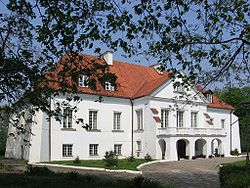Kalinowa (Błaszki)
| Kalinowa | ||
|---|---|---|
 Help on coat of arms |
|
|
| Basic data | ||
| State : | Poland | |
| Voivodeship : | Łódź | |
| Powiat : | Sieradz | |
| Gmina : | Błaszki | |
| Geographic location : | 51 ° 42 ' N , 18 ° 29' E | |
| Residents : | ||
| Postal code : | 98-235 | |
| Telephone code : | (+48) 43 | |
| License plate : | IT I | |
| Economy and Transport | ||
| Next international airport : | Łódź | |
Kalinowa is a village of Gmina Błaszki within the powiat Sieradzki , Łódź Voivodeship , in central Poland . It is located about 6 km northeast of Błaszki , 21 km from Sieradz and 69 km west of the regional capital Łódź .
History and monuments
The first mention of the village can be found in written sources from 1370 as Arkembold heres de Kalinowa . It is the ancestral seat of the noble family Zaremb, from which great Sieradz and Kalisz voivodes can be derived as well as Sieradz Burgvogts, Wieluńer and Grabówer Starosten . You were the owner of a large estate in the center of Kalinowa, which included 15 villages in the Sieradz area and at least as many around Kalisz.
The mansion
At the beginning of the 17th century, Kalinowa became the property of Wojciech Jan Łubieński († 1653), who had the baroque manor house built here in the village, most likely before 1652 ; a multi-storey building with a low ground floor, risalits and arcades , beautifully tiered from the front. The last owner from the noble family Łubieński was Feliks Łubieński (1758-1848), who in 1797 moved his residence to Guzów . From a “Diary of the Łubieńskis” and the correspondence of his son, General Tomasz Łubieński (1784–1870), we know quite a bit about the family as a whole. In Kalinowa Władysław Aleksander Łubieński became a Polish primate who crowned Stanisław August Poniatowski as King of Poland .
From 1797 Kalinowa was owned by the Murzynowskis. Her manor house, chosen in 1865 as the model for the Straszny Dwór (Enchanted Castle) in Stanisław Moniuszko 's opera of the same name, is still the epitome of the haunted castle in Poland thanks to the patriotic content of this work. In 1916, the Murzynskis had fundamental restoration work and extensive renovations carried out on the manor house.
After the first abolition of the Polish nobility in 1921 and after the second abolition in 1945, he was left with his mansions (which, however, they had to share with many other tenants assigned by the Housing Office) and residual property until around 1947. After that, they were expropriated by the communists . In the years 1949-60 the manor house was used as a school building, then by the Stacja Hodowli Roślin as a breeding station for agricultural production. On July 1, 1993, the lease with the Agencja Nieruchomości Rolnych (ANR) (Agricultural Real Estate Agency) ended and the mansion lay fallow for ten years. On January 14, 2003 the lease with agricultural production companies was renewed until 2023. In 2010, shares were sold to AGROSAD at a price of PLN 8,728,500.
From the original Straszny dwór , only the historical vault in the basement has been preserved except for the exterior view. The oak staircase in the lower lobby area was destroyed during renovation work. The park behind the manor house, once laid out as an English landscape garden , is neglected, in it a pond with an island covered relics of the former knight fortress of the Zarembs (probably used from the 15th century until the Murowan seat was built).
Catholic Church of St. Mary Magdalene
In the village there is also the Gothic Church of St. Mary Magdalene (Kościół pw. Św. Marii Magdaleny w Kalinowej), built by Jan Zaremb from 1465 to 1468, completely restored at the beginning of the 19th century. It houses a main altar in the rococo style and a side altar in the classicist style of the 19th century.
Web links
credentials
- ↑ Central Statistical Office (GUS) - TERYT (National Register of Territorial Land Apportionment Journal) ( Polish ) June 1, 2008. Retrieved September 24, 2013.

